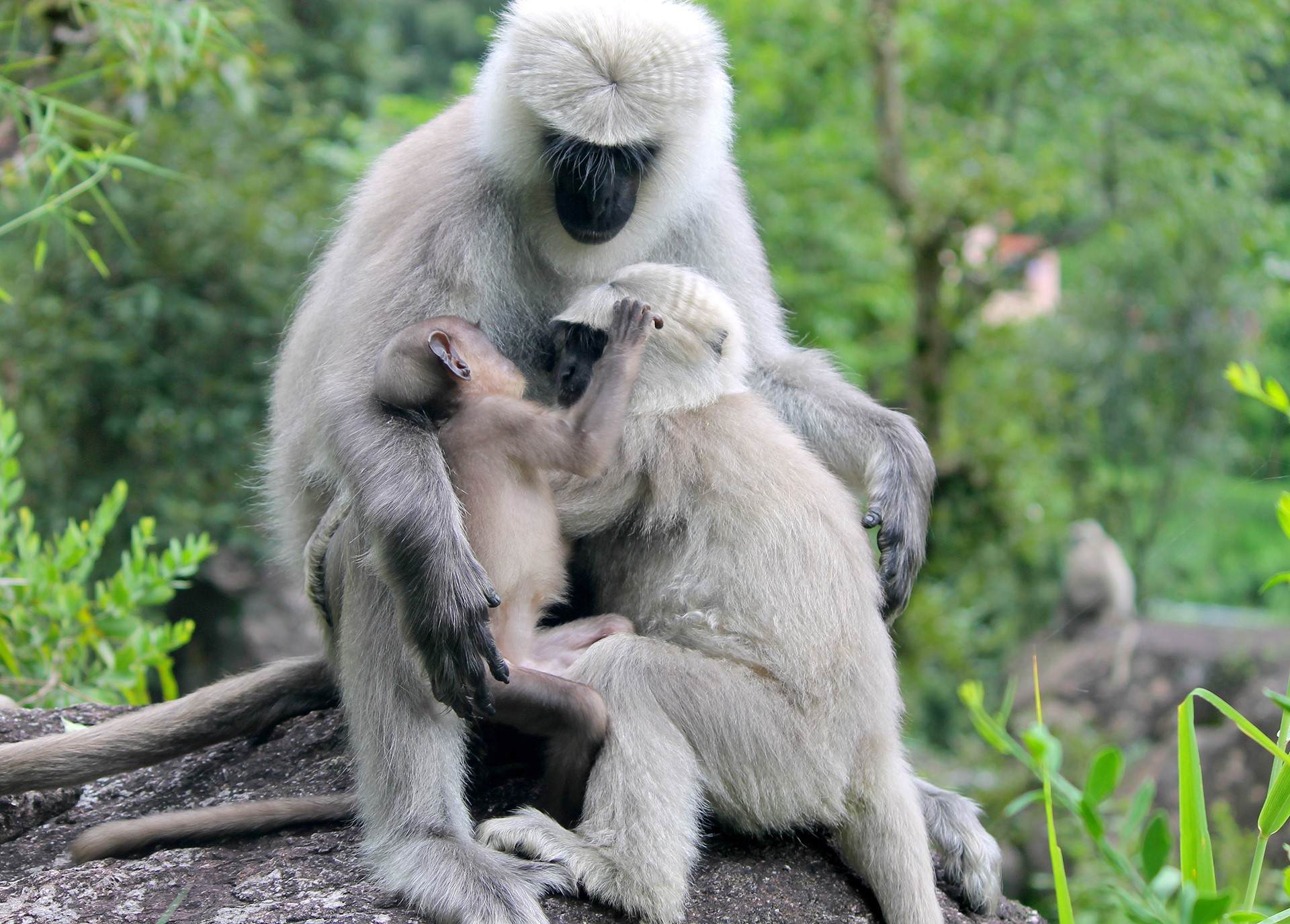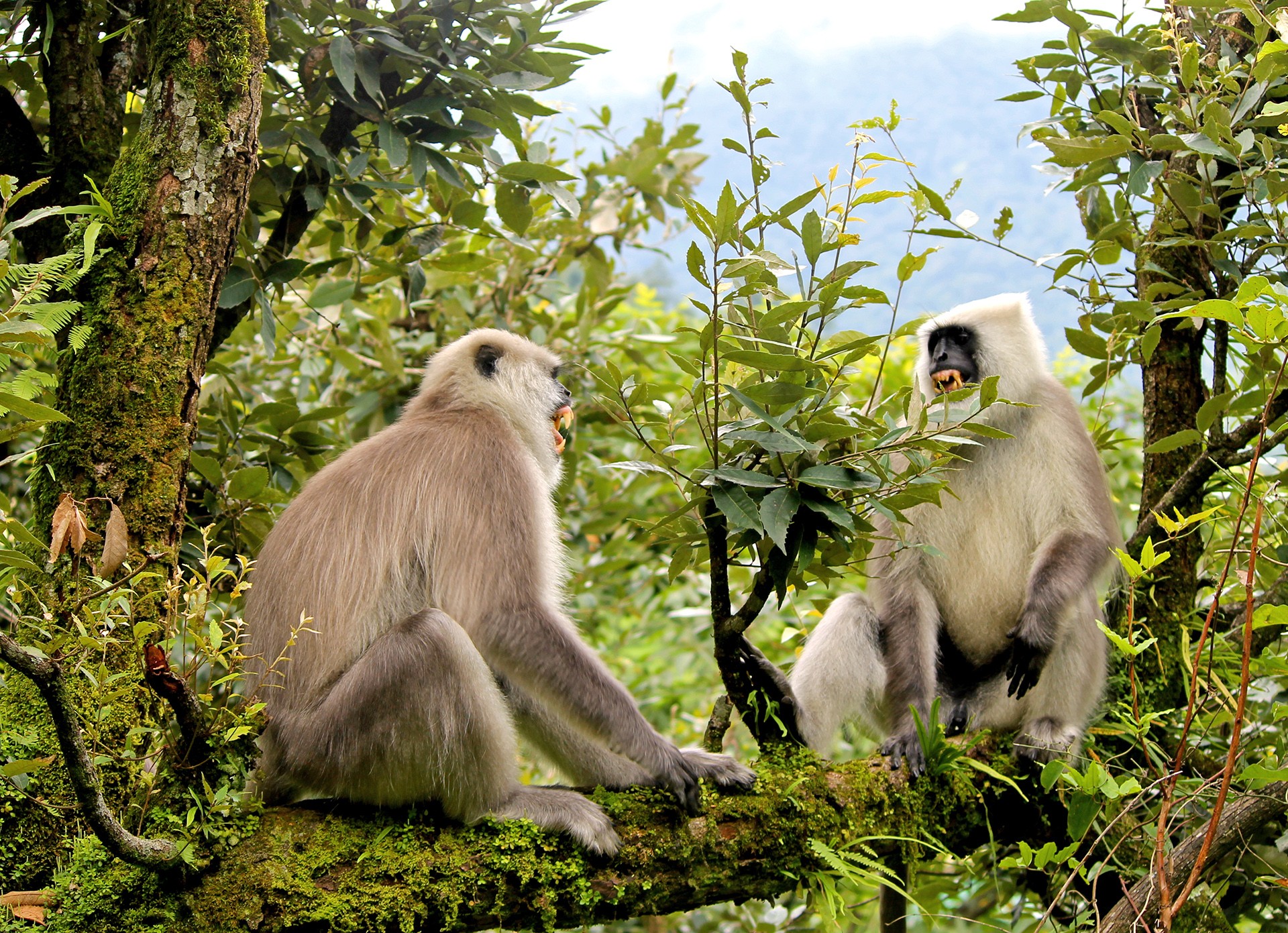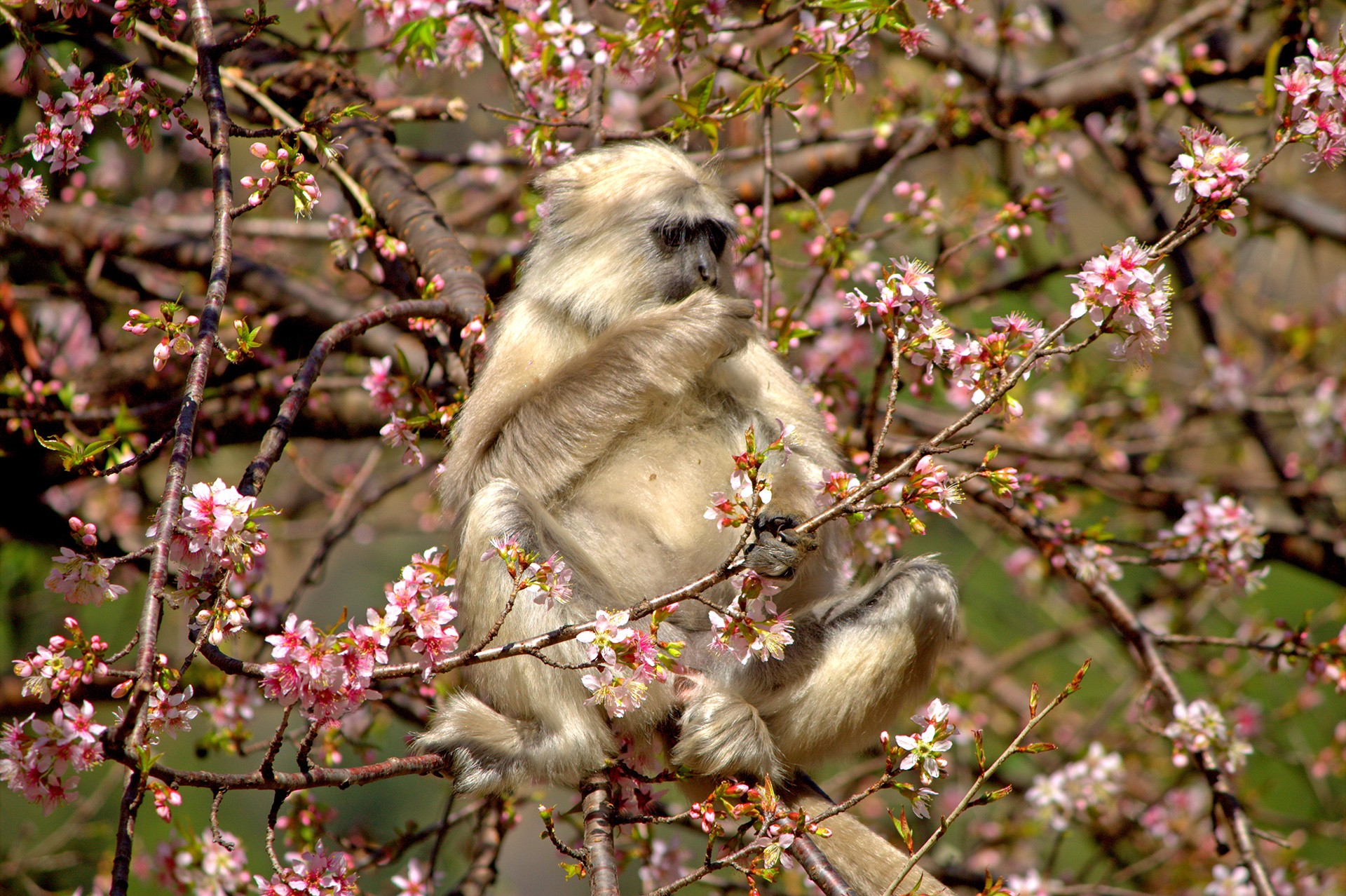Let me begin by telling you that following Central Himalayan Langurs (Semnopithecus schistaceus) is not an easy task. Walking uphill for three hours early one morning in the month of May, I finally reached the highest point of Mandal Valley, Uttarakhand, which is engulfed by Himalayan peaks. From this vantage point, I could see the whole valley sprawled ahead of me, the fast-flowing river cutting through it and the lush green forest. The vista was dotted with a number of small villages and agricultural fields. I scanned the valley, searching for the troop that I had just started studying in the early days of my research. I spent a little longer looking towards their favoured places such as farm lands, the riverbed, and patches of oak forest at the periphery of the village.
Every day would go much like this. I would search for the langurs in this western Himalayan region from early morning till late in the evening. I would take photographs, and make notes on their activities and behaviour. I would watch them for hours, trying to understand what it’s really like to be a Himalayan Langur.
When I first started my research, it would take around 8-10 hours to find them, as I had no idea where the langurs went, or where they slept. Sometimes, I think langurs have an innate instinct to escape the eternal pusuit of an annoying, hawk-eyed primatologist. Sometimes, they just disappeared within the canopy; sometimes, they used more direct techniques, like vacating their bowels while perfectly aimed at me.
In the early days of my research, it was really challenging to approach nearby troops and get them habituated to my constant presence. I was attacked and even mocked many times when langurs wanted to show me my place. The adult males did not want to tolerate the presence of a (potentially threatening) human troop nearby, so when I approached, they generally showed their dislike by aggressively displaying their canines or by grinding their teeth.
Now, after three years, I know my troop home range very well. Langurs usually follow the same path, so with time, it becomes easier to predict their next sleeping or resting site. And with a lot of patience, I have managed to habituate a troop of 50 individuals in Mandal village. Now, I can freely observe each individual from around 2-3m away, or closer when they are on the ground. I have come to know their personalities and specific traits. This acceptance by the langurs in the troop has allowed me to understand them more deeply – not just as an outsider, but almost as a member of a close-knit family.
The typical family of Himalayan Langurs comprises 4-7 adult males and multiple adult females, along with sub-adults (4-6 years old), juveniles (2-3 years old) and infants. The troop adheres to a strongly hierarchical system, governed by strength and power. As one goes deeper within their family structure, the beautiful web of interactions between sexes and classes becomes clearer. Every individual has their own role to play. I’m taking the liberty here to modify a quote on wolves by Rudyard Kipling, as it holds true for this social animal as well: For the strength of the troop is the langur, and the strength of the langur is the troop.
Managing a troop of 50-60 individuals is very challenging in the harsh Himalayan landscape, but langurs have adopted the perfect solution: having more males in the troop. Adult males protect the troop from ferocious predators like the Common Leopard at night and guard dogs during the day. When multi-male troops travel longer distances to explore other feeding patches, one male leads the troop, some males stay with the troop as they move to their destination, and other males follow towards the end to assure that no one is left behind. All adult males are responsible for safety, movement, and proper regulation of the troop.
But of course, the presence of multiple adult males results in a lot of fights as well as tensions, especially during the mating season. Though when it comes to maintaining the troop’s safety, they do show mutual cooperation.
Females are responsible for maintaining social relationships in the troop, which help reduce the tensions between the troop members. Females help other females carrying young infants, giving new mothers a much-needed break from taking care of their baby, and allowing them some time to feed and groom themselves. Juveniles and sub-adults also help take care of the young babies. Generally, we assume that it is the mother who teaches young babies what to eat, what to avoid, how to play, and so on. But in langur troops, the juveniles and sub- adult in the family play that role. While adult females, including the mothers, spend time socialising (basically, grooming other individuals) and feeding, these juvenile and sub-adults spend time playing with the babies. As the infants grow, they follow them and learn to eat whatever their elder brothers and sisters are feeding on. Each and every individual counts for the wellbeing of the troop.
Langurs at different altitudes
Currently, we do not have any information about the phylogeny of Himalayan Langurs, which means that we currently describe them without DNA, population and morphology studies (at this point, it is difficult to say anything about the Himalayan Langurs at a sub-species level). We would need to sample Himalayan populations from Pakistan, Nepal, and Bhutan, as well as India, to understand more about their genetic origins. This will help us compare data from different langur range zones. There are seven species of Hanuman/ Gray langurs in India. There is no phylogeny study for the Himalayan Langur as of now,
So far, I have studied four different troops inhabiting altitudes from 1,500m to 4,000m. This range covers four different forest types of the Himalayas: Temperate oak forest, fir forest, timberline ecotone and alpine meadows. Each habitat and forest type bring its own challenges, but also provides opportunities to study the differences between langurs at different altitudes.
As altitude changes, so too does the weather and the composition of vegetation, which results in some behavioural changes in animals too. Langurs’ social interactions and feeding habits vary with increasing altitude in the Himalayas. One major change, of course, is to their diet. Langurs are primarily leaf-eaters: their diet mainly comprises leaves or other plant parts such as flowers, fruits, and roots. But with increasing altitude, where the diversity of plants and trees is reduced, I have observed langurs feeding on insects hidden under the moss, earthworms in marshy land and the larvae of mayflies in the flowing streams. Interestingly though, their digestive system is not suited to anything except leaves or plant parts. But in the higher Himalayas, they exhibit amazing adaptation to get the protein they need by consuming insects – this adaptation is key to surviving the harsh weather conditions.
Another difference I have observed with altitude is in their social behaviour. Social activities such as grooming are an important part of life for social animals – they aid in cohesion, which, in turn, affects their survival and reproductive efforts. Because altitudinal changes coincide with changes in flora and their availability, troops dwelling in high altitudes need more time to search for food, to feed and to rest (in order to aid digestion and thermoregulation). This appears to have negatively affected the amount of time left for social activities.
Langurs and climate change
Another thing that is likely to affect langur behaviour is climate change. While the impact of climate change is a topic of global concern, currently, we know next to nothing about its possible impact on primates living at high altitudes. An earlier five-year study conducted at Rudranath meadows, my high-altitude site, demonstrated that biotic pressures (for example, livestock grazing) and climate change are responsible for changes in the vegetation composition of these meadows.
Warming temperatures are causing the upward migration of timber line vegetation. As langurs mainly live in the timber line and depend on sub-alpine meadows for feeding, changes in the timber line also change the ranging pattern of langurs.
This extension of range for langurs will definitely have an impact on troops at this elevation, and studying the effects of climate change on their social behaviour and diet is part of my ongoing research. However, we will need many more focused studies to investigate these patterns over multiple years at multiple sites before we can formulate conservation efforts to save the species.
Coexistence with langurs
There was a conflict between langurs and the people that share their habitat at all the altitudes I have studied. Now that you know a bit about langur family structure, and, I assume, are well versed in human family structures, I have a question for you. What is your opinion about langurs and humans sharing the same area? Both have families to take care of, both need food as well as space to survive. But because both species fulfil these common needs using resources from the forest, invariably, there is conflict. We may have intelligence on our side, but they have the strength of the troop, which makes this war one with no real winners.
Take the situation in valleys at lower altitudes surrounded by human settlements. In the Mandal valley, where I am currently studying troops of langurs and local people’s perceptions about them, I often see langurs in the agricultural fields – mostly of finger millet and wheat – and people chasing them into the nearby forests.
So how can these endless conflicts be mitigated, or even resolved? Of course, asking questions like this is far easier than finding a sustainable solution.
The cultivation of alternative crops is not really an answer for mountain people because they follow tradition strongly. We have to find measures which don’t change their way of living.
In my years of study, I’ve come to realise that the fix might lie in two important tree species: oak, and Himalayan cherry. Oak is cut down by the local people for fodder and firewood. Himalayan cherry, on the other hand, is useless to them – it doesn’t have any value as fodder or firewood. So people don’t plant these trees anymore; and where they exist, they are likely to be cut down too, to clear the area for grass or other useful trees. Both species are scarce in the adjoining forests, but are highly valuable for the langurs as it provides them with food and shelter. So, the troops have had no choice but to turn towards an alternative solution: agricultural crops and fodder trees inside the fields, causing direct conflict with humans. How can these battles be mitigated? In my view, the answer is simple. It lies in planting these two important tree species in adjoining forests of the villages.
This year, I began doing this with the help of locals, but we have to wait for the results. Himalayan cherry is fast growing, but it will still take around 5-6 years to be a food source for langurs.
In Rudranath, a high-altitude meadow at about 3500m, even though there are no human populations inhibiting this area, the story is the same here too. Every year, herders from Mandal Valley take their cattle to graze in these meadows in summer. The langurs who inhabit these high-altitude meadows are forced to compete for highly seasonal food resources with these livestock around the sparse vegetation close to timberline.
I just started my research in this new area. Currently, I am studying which plants are highly damaged by the goats and how much these plants contribute to the langurs’ diet. Areas depleted by grazing will force langurs to travel long distances in search of food. More time spent foraging means there will be less time for social activities, and less social interaction will have significant effects on their social behaviour. This, too, is part of my ongoing research, and I am still collecting data on it.
I am very keen to explore ways to mitigate these problems and to generate sustainable solutions with the participation of local people. Clearly, this will require more detailed studies and more importantly, a long-term commitment to this area, to its wildlife and to its people.
I am already doing my little bit for langurs. They have as much right as we do to stay on this planet. Though the odds are stacked against us, whenever I look into the eyes of the playful babies in the troops, I am filled with a mysterious joy and hope that we can coexist. So every day, I continue to look for viable solutions to ensure the peaceful existence of both species.











